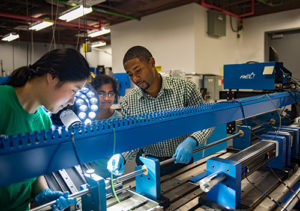TRANSFORMING HOW THINGS ARE MADE
Imagine transforming how things are made. That’s what the University of North Texas’ (UNT) Center for Agile and Adaptive Additive Manufacturing aims to do.
Launched in 2018, the center is honing manufacturing technologies to better build complex 3D objects, with the goal of creating viable market-based solutions for almost every industry, from operating rooms to oil fields, while producing practically zero waste and substantial cost savings.
Since it opened, the center has become one of the most advanced university research facilities in the nation for materials analysis, allowing collaboration among students, faculty and industries.

Additive manufacturing may sound complicated, but the theory isn’t. Instead of building a sandcastle by subtracting sand away from a pile until the structure appears, imagine adding sand beginning at the bottom and moving up layer by layer until a castle is built. In the application of additive manufacturing, the grains of sand would be placed one at a time in a specific order, predetermined by an enhanced computer design.
“Additive manufacturing is a new area of engineering,” says Rajarshi Banerjee, Regents Professor and director of UNT’s Materials Research Facility. “As such, there are many unexplored areas and unanswered questions. For example, we are finding that the structure of certain metallic materials has fundamentally changed after going through this process. The aluminum alloy powder used to create a component using additive manufacturing technology may look the same and be chemically similar to those produced using traditional manufacturing, but it has a different microscopic structure and properties. The question we are trying to answer is ‘Why?’”
Most additive manufacturing involves plastics and polymers; UNT has expanded the materials involved to include metals, ceramics and metal-ceramic composites. Due to the change that occurs to materials during processing, Banerjee’s research also involves the creation of additive-manufacturing-specific alloys. These alloys are better adapted to additive manufacturing processes and provide for a consistent end product.
The center received a $10 million boost from the 86th Texas Legislature, further advancing its work — dubbed “a fourth Industrial Revolution” — the fusion of manufacturing design, process and production.
This article is part of the 2020 Higher Education Review Magazine.